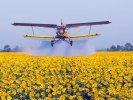Eye For Film >> Movies >> Our Daily Bread (2005) Film Review
“Let’s go and see a documentary about food production,” may not sound like much of an invitation. But give this a try and you may be pleasantly surprised.
This is the third film by German director Geyrhalter, who claims to be fascinated by zones and areas people don’t normally see. We all have vague and often wrong ideas about where our food comes from. The images used in advertising are deliberately misleading. Modern food production has nothing to do with little mixed farms where lambs frolic in the sunshine. But nor should you expect a polemic about the evils of animal slaughter.

This film has no dialogue, no music or voiceover. From time to time we hear human voices in the background. The location and language don’t matter. The scenes could be anywhere in Europe. The stunning visuals speak for themselves. Prepare to be absorbed, fascinated, disturbed.
What comes over very strongly throughout is the quiet, casual, repetitive nature of the work. In an early scene a woman at a conveyor belt is scooping handfuls of chicks out of trays to weigh them. They are fed onto a moving belt and over rollers, then shot out of a machine like yellow tennis balls. Another woman is throwing them into more trays. She chats casually to a workmate who picks up a few dropped ones from the floor and tosses them back to her. At the end of this sequence one, presumably a reject, is tossed under the table into a bin and the woman walks away. (Is it the end of her shift or is she just off to fetch the next tray?)
This is a world of machines. A crop sprayer extends its arms like an alien, ready to begin work. Another machine gutting fish looks like a group of vicious pecking birds. But people do the jobs the machines can’t do, whether alone like the young woman cutting the heads off an endless row of dead chickens or in teams like the man pushing a trolley along a line of cages while a woman stands on the trolley checking for dead birds.
Everything continues round the clock, and everything is on an enormous scale. A tractor comes up to an olive tree, a grabber shakes the tree, another tractor comes with a scraper, rounds the tree picking up the olives and dumps them onto a sheet. Then the camera pulls back to show hundreds of olive trees, then back again and we see tens of thousands. Some jobs could have come from Greek myths, like the man walking along a line of dying pepper plants, cutting them out of their gro-bags. The line just goes on forever.
People work like machines and yet they are still seen to be human. In silence, we see them smoking, eating their lunch between shifts. An attractive young woman has put on makeup to come to work in the slaughterhouse, and she sits chewing gum as she waits for hanging pigs to come round, then she cuts off their trotters with big mechanical secateurs.
If this sounds grim, it isn’t. There are scenes of astonishing beauty, water dripping onto vivid green plants, shoals of silver fish, a yellow biplane over a field of sunflowers. Often it isn’t immediately clear what we are looking at. A bus takes workers to what looks like a lake, but is in fact a vast area covered in plastic. Some scenes have an alien quality. A long way down in a lift and a long drive underground brings us to a huge echoing saltmine where the humans and their machines look like toys.
It is not until half way through the film that we see any animals being killed, and the most disturbing scenes are in the final few minutes, when cows seem to sense what is about to happen to them and their brief struggle is sad. But no one should be put off seeing this remarkable and memorable film. This is our world. This is the food we eat. Our daily bread.
Reviewed on: 22 Jan 2008
















